Pattadakal, the capital of the Chalukya dynasty of medieval India, is 22 km away from Badami and 514 km from Bangalore. This town is famous for its group of monuments that are the culmination of earliest experiments in vesara style of Hindu temple architecture, built in 680. The temple was started in nagara style but later changed to a more balanced Dravidian style. Sculptures here speak of scenes from Ramayana and Mahabharatha. This temple has many similarities with the Navabrahma temples in Alampur, Andhra Pradesh, which were also built by the same dynasty.
History
The Pattadakal group of monuments was built in the 7th and 8th centuries and was situated in the southern State of Karnataka. Pattadakal was not only popular for Chalukyan architectural activities but also a holy place for royal coronation, `Pattadakisuvolal`. The temples have a harmonious blend of architectural forms of northern and southern India; Rekha Nagara Prasada and the Dravida Vimana styles of temple building.
Site & Architecture
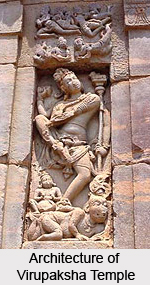 The sculptural art of the early Chalukyas is characterized by grace and delicate details. Chalukyan rulers were not only empire builders, but great patrons of art whose encouragement prompted the artists and craftsmen to experiment and innovate in different architectural styles and giving it a new dimension. It is in their period that transition from rock-cut medium to structural temples took place. The ceiling panels of the navagrahas, dikpalas, the dancing Nataraja, the wall niches containing Lingodbhava, Ardhanarisvara, Tripurari, Varahavishnu, Trivikrama bear ample testimony to the sculptor`s skill as well as the cult worship that was in vogue.
The sculptural art of the early Chalukyas is characterized by grace and delicate details. Chalukyan rulers were not only empire builders, but great patrons of art whose encouragement prompted the artists and craftsmen to experiment and innovate in different architectural styles and giving it a new dimension. It is in their period that transition from rock-cut medium to structural temples took place. The ceiling panels of the navagrahas, dikpalas, the dancing Nataraja, the wall niches containing Lingodbhava, Ardhanarisvara, Tripurari, Varahavishnu, Trivikrama bear ample testimony to the sculptor`s skill as well as the cult worship that was in vogue.
This site consists of a group of ten major temples, each displaying interesting architectural features and representing the high point of an eclectic art. It consists of nine Hindu temples, as well as a Jain sanctuary, surrounded by numerous small shrines and plinths. The group of mounuments in Pattadakal was designated a World Heritage Site in 1987. Four temples were built in Dravidian style, four in nagara style of Northern India and the Papanatha temple in mixed style can be seen here:
Sangameswara Temple is the oldest of all it is the simple but massive temple, 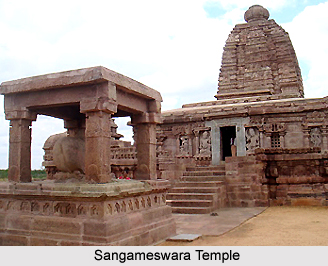 built by Chalukya Vijayaditya Satyasraya (AD 697-733), is nearer the Pallava form in that it has no sukanasika, while the other two, which possess this, are the earliest of the Chalukyan type and its derivatives possessing this architectural member, as also does the Kailasa at Ellora. The main vimana of the Sangamesvara is of three storeys. The lowermost storey is surrounded by two walls, the inner and outer, the second storey being an upward projection of the inner wall, while the outer wall encloses the covered circumambulatory round the sanctum. Though this temple is incomplete, it is yet attractive.
built by Chalukya Vijayaditya Satyasraya (AD 697-733), is nearer the Pallava form in that it has no sukanasika, while the other two, which possess this, are the earliest of the Chalukyan type and its derivatives possessing this architectural member, as also does the Kailasa at Ellora. The main vimana of the Sangamesvara is of three storeys. The lowermost storey is surrounded by two walls, the inner and outer, the second storey being an upward projection of the inner wall, while the outer wall encloses the covered circumambulatory round the sanctum. Though this temple is incomplete, it is yet attractive.
The Virupaksha Temple was built by the queen of Vikramaditya II (733-46) is the earliest dated temple with the Sukanasika, being closely followed by the Mallikarjuna, built by another queen of the same king. This masterpiece stands out entirely from the 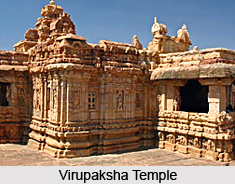 group. It was built in the 740 century by Queen Lokamahadevi to commemorate her husband`s victory over the kings from the South, which was originally called as `Lokeshwara`. This temple is built in the southern Dravida style, influenced by the architecture of the Kailasanatha temple at Kanchipuram and is the largest in the enclosure. It has a massive gateway and several inscriptions. The Virupaksha temple is rich in sculptures like those of lingodbhava, Nataraja, Ravananugraha and Ugranarasimha. This temple also served as a model for the Rashtrakuta ruler Krishna I (757 -783 A.D.), to carve out the great Kailasa at Ellora.
group. It was built in the 740 century by Queen Lokamahadevi to commemorate her husband`s victory over the kings from the South, which was originally called as `Lokeshwara`. This temple is built in the southern Dravida style, influenced by the architecture of the Kailasanatha temple at Kanchipuram and is the largest in the enclosure. It has a massive gateway and several inscriptions. The Virupaksha temple is rich in sculptures like those of lingodbhava, Nataraja, Ravananugraha and Ugranarasimha. This temple also served as a model for the Rashtrakuta ruler Krishna I (757 -783 A.D.), to carve out the great Kailasa at Ellora.
The Virupaksha is a large complex consisting of a tall vimana with axial mandapas and peripheral sub-shrines round the court, enclosed by a wall with gopura-entrances in front and behind, all designed and completed at one time. As such, this is the earliest extant temple-complex in the Chalukyan series. The massive gopuras are also the earliest. The compound-wall of the complex, following the plan of the group itself, has on its coping kuta and said-heads, suggestive of a derivation from the Shore-temple at Mahabalipuram-a device which gives the impression of a lower storey when viewed from a distance.
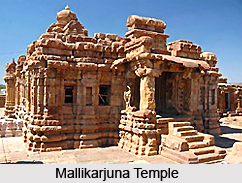 The Mallikarjuna Temple is as similar to the Virupaksha temples, since it was also built by another queen of Vikaramaditya II, immediately after and close to the former one, to commemorate the victory of the Chalukyas over the Pallavas. The Mallikarjuna is a smaller temple with a four-storeyed vimana with a circular griva and sikhara. Another similarity in its architecture is that, to a large degree, it exhibits the southern elements in their vimanas, as crystallized in the contemporary Pallava temples. Both the Sangamesvara and the larger Virupaksha are similar to each other in being square on plan from the base to sikhara.
The Mallikarjuna Temple is as similar to the Virupaksha temples, since it was also built by another queen of Vikaramaditya II, immediately after and close to the former one, to commemorate the victory of the Chalukyas over the Pallavas. The Mallikarjuna is a smaller temple with a four-storeyed vimana with a circular griva and sikhara. Another similarity in its architecture is that, to a large degree, it exhibits the southern elements in their vimanas, as crystallized in the contemporary Pallava temples. Both the Sangamesvara and the larger Virupaksha are similar to each other in being square on plan from the base to sikhara.
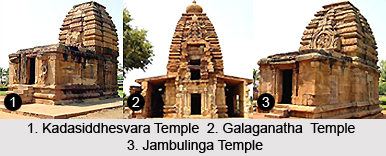 The other notable temples at Pattadakal are the Kadasiddhesvara, Jambulinga and the Galaganatha temple, attributed to 7th century A.D. The Galaganatha temple was built a century later in the style of rekha nagara prasada style. It contains a sculpture of Lord Shiva killing the demon Andhakasura. The Kadasiddeshvara temple has a sculpture of Shiva holding a Trident or Trishul in his hands and its twin temple, whereas the Jambulinga Temple has a fine figure of the Dancing Shiva with Nandi (bull) & Parvathi by his side. They are all built in nagara style and resemble the Hucchimalli` Guddi at Aihole. It is built with a northern style tower there is a horse-shoe arched projection on its facade. The Chandrashekhara and Kadasiddhesvara are also the other major temples here and Pattadakal also has a Jaina basadi of Rashtrakuta times with two beautiful elephants in front.
The other notable temples at Pattadakal are the Kadasiddhesvara, Jambulinga and the Galaganatha temple, attributed to 7th century A.D. The Galaganatha temple was built a century later in the style of rekha nagara prasada style. It contains a sculpture of Lord Shiva killing the demon Andhakasura. The Kadasiddeshvara temple has a sculpture of Shiva holding a Trident or Trishul in his hands and its twin temple, whereas the Jambulinga Temple has a fine figure of the Dancing Shiva with Nandi (bull) & Parvathi by his side. They are all built in nagara style and resemble the Hucchimalli` Guddi at Aihole. It is built with a northern style tower there is a horse-shoe arched projection on its facade. The Chandrashekhara and Kadasiddhesvara are also the other major temples here and Pattadakal also has a Jaina basadi of Rashtrakuta times with two beautiful elephants in front.
The Kasivisvesvara Temple was the last to be built in early Chalukyan style. The Mallikarjuna temple was constructed by Rani Trilokyamahadevi to celebrate the victory over the Pallavas by Vikramaditya II. However, the last addition at Pattadakal was made during the reign of Rashtrakuta ruler Krishna II of the 9th century A.D. in form of a Jaina temple, locally famous as Jaina Narayana, with its two lower storeys functional.
The Jain Temple located on the Pattadakal-Badami Road, is built in the Dravidian style by the Rashtrakutas of Manyakheta. It has some very beautiful sculptures & probably dates from the 9th century and was built by either King Amoghavarsha I or his son Krishna II. Other important monuments here are the monolithic stone pillar bearing inscriptions, Naganatha temple, Chandrashekara temple and inscriptions in the Mahakuteshwara temple. Even the Museum of the Plains and Sculpture gallery is maintained by the Archeological Survey of India on the Bhutanatha temple road.



















